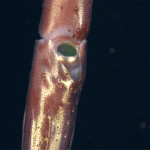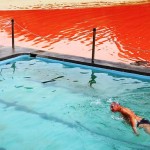In the videos above and below you see the Electric Flame Scallop, also called the Disco Scallop. Technically its not a scallop. Its not in the same family (Pectinidae) or even Order (Osteroida). Nope this guy or gal is the family Limoida in order Limoida. They are about as different to one another as a bat to whale (also in different taxonomic orders). Of course, I’m just pissy because I study mollusks. The real reason I posted, and not just to bitch, is that because of the spectacular
UPDATE: Lindsey Dougherty commented below. Lindsey is graduate student at the University of California, Berkeley whose research I completely missed when I wrote this. As she mentions below in the comments, the species is actually Ctenoides ales. Lindsey presented work recently at the Society of Integrative and Comparative Biology meeting both determining the evolutionary relationships of this unique bivalve but how it generates light. As she mentions in her abstract, these are the only known bivalves with a light display. These critters actually ARE NOT BIOLUMINESCENT. Part of their mantle is actually iridescent and the clam actually furls and unfurls the reflective bits to cause the light show. Pretty cool stuff and sorry to Lindsey.






The species is actually Ctenoides ales, the phylogeny was revised several times. The flashing phenomenon isn’t actually bioluminescence, it’s a type of structural reflection due to electron-dense particles in the tissue. “Electric scallop” is one of many colloquial names (I’ve heard “electric clam”, “disco clam” and “disco scallop” also, and although scallop is incorrect in a strict phylogenetic sense, file clams do resemble scallops in many morphological characteristics, so they’re probably easily confused. Great video and post!
No need for a sorry, thanks so much for the mention! They’re incredibly fascinating creatures and I’m very happy people are interested in them. Hoping to unravel more about the behavioral purpose behind the light display soon, stay tuned!
“Electric scallop” would be a great band name (I’m pretty sure “The Electric Clam” is already taken.
But I too am curious as to why a bivalve would exhibit such a display; molluscs have the widest variety of eye morphologies, but are they really able to interpret this somehow? Or is the display for other species (predators?) with more well developed eyes? Since human vision is limited to the (anthropomorphically named) “Visual Spectrum” perhaps (since this isn’t a case of bio-luminescence) it’s merely a fluke that *we* see such a display. In it’s natural environment, amongst it’s natural fauna perhaps it’s a much more banal display. I’m curious to see what the display appears like when IR and UV or limited spectrum interpretation are factored in.
Fascinating.
Haha yes, perhaps the “Electric Scallops” band will be my plan B in case this whole PhD thing doesn’t work out. The display is very curious indeed – it’s hard to argue that it’s simply a function of ontogeny, as the reflective cells are very distinctly arranged on only half of the mantle and correlated with tissue movement in the same area. Working hypotheses include prey luring to supplement filter feeding, some sort of aposematism, or perhaps luring of juveniles for settlement to facilitate proximity when mass spawning. I’ve also spoken to a few people about further investigating their eyes. The spectrum question is also interesting, although most of what is reflected seems to appear in the visual spectrum and is weighted toward blue light. Regardless, very intriguing – I’ll keep you updated with findings!